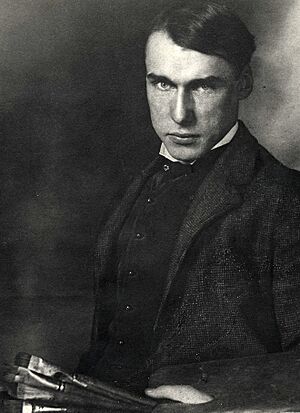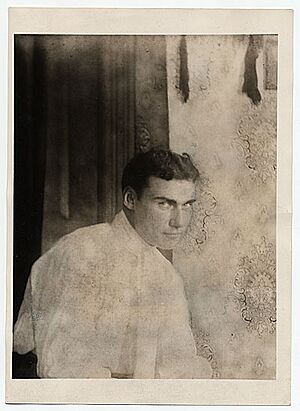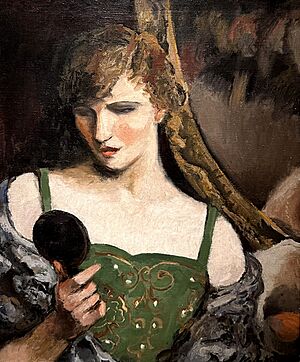Walt Kuhn facts for kids
Quick facts for kids
Walt Kuhn
|
|
|---|---|

circa 1904
|
|
| Born | October 27, 1877 |
| Died | July 13, 1949 (aged 71) |
| Nationality | American |
| Known for | Painting, modern art |

Walter Francis Kuhn (born October 27, 1877 – died July 13, 1949) was an American painter. He is famous for helping to organize the Armory Show in 1913. This show was a big event that introduced American audiences to new and exciting European modern art for the first time.
Contents
Walt Kuhn's Life Story
Early Life and Art Training
Walt Kuhn was born in New York City in 1877. He grew up near the busy Red Hook, Brooklyn docks. His family was working-class, and he saw many interesting things there. Even though he loved to draw, no one expected him to become an artist.
His first jobs were running a bicycle repair shop and racing bikes professionally. But when he was fifteen, Walt sold his first drawings to a magazine. He then started signing his name "Walt." In 1893, he decided to get proper art training. He joined art classes at the Brooklyn Polytechnic Institute.
Studying Art in Europe
In 1899, Kuhn traveled to California with only sixty dollars. He became an illustrator for WASP Magazine in San Francisco. He soon realized he needed to see the art of Europe to grow as an artist. He wanted to study the "Old Masters" and new modern artists.
So, in 1901, at age twenty-four, Kuhn went to Paris, France. He briefly studied art at the Académie Colarossi. Then he moved to the Royal Academy in Munich, Germany. In Munich, he learned from Heinrich von Zügel. He also took sketching trips in the Netherlands and visited museums in Venice, Italy. During his two years abroad, Kuhn saw the work of Impressionist and Post-Impressionist artists for the first time.
Return to New York and Family Life
Kuhn came back to New York in 1903. He worked as an illustrator for local magazines. In 1905, he had his first art show at the Salmagundi Club. This helped him become known as both a cartoonist and a serious painter. That same year, he started drawing for Life magazine.
From 1909 to 1910, his comic strip "Whisk" was in the New York World newspaper for almost two years. He was friends with other cartoonists like Gus Mager and Pop Hart. He even created his own text comic called Whisk.
In 1908, Kuhn taught at the New York School of Art. But he didn't enjoy it much. After a year, he returned to New York City. There, he married Vera Spier, and they soon had a daughter named Brenda Kuhn. During this time, he also became good friends with artist Arthur Bowen Davies. Davies would later play a very important role in American art history.
The Famous Armory Show
In 1909, Kuhn had his first solo art show in New York. In the next few years, he helped start the Association of American Painters and Sculptors. This group was responsible for the famous Armory Show. Kuhn was the executive secretary and helped find European artists for the show.
In 1912, he, Davies, and artist Walter Pach took a quick trip around Europe. They wanted to find the newest and most daring art to bring to New York. Kuhn visited a big art show in Cologne, Germany, which inspired him. The Armory Show in 1913 displayed both European and American modern art. It caused a lot of talk and was a huge success!
Smart advertising and word-of-mouth helped bring over 200,000 visitors. The show sold over $44,000 worth of art, which was much more than anyone expected. After New York, the Armory Show traveled to Chicago and Boston. Art critic Robert Hughes said, "Kuhn had a talent for promotion." This amazing show proved that Americans were ready for modern art. It also showed there was a big market for it. Kuhn played a huge part in this important cultural event.
After the Armory Show
After the Armory Show, Kuhn became an art advisor for lawyer and collector John Quinn. He helped Quinn build a special collection of modern art. Sadly, Quinn's collection was sold after he died in 1924. Kuhn also showed his art at the Whitney Studio Club. He became a well-liked artist at the Whitney Museum of American Art.
In the 1910s, Kuhn's art often showed the influence of the modern European painters he had helped promote. For example, his painting The Polo Ground (1914) looked a lot like the work of Raoul Dufy. Other art experts noticed similarities to André Derain and German Expressionist artists. By the end of the decade, Kuhn's paintings became more traditional again. However, he never painted like a strict realist. His portraits and still lifes used bold brushstrokes, strong colors, and thick textures. You can always tell a Kuhn painting by its unique style.
Later Years and Health Challenges
In 1925, Kuhn became very ill with a stomach ulcer. After a difficult recovery, he started teaching at the Art Students League of New York. He also completed a special project for the Union Pacific Railroad. He designed a club car called "The Little Nugget" LA-701. This car is now being restored at the Travel Town Museum in Los Angeles, California.
In 1933, the older artist organized his first show looking back at his entire career. During these years, he started to question his earlier strong support for European Modernism. In 1931, he traveled to Europe with Marie and W. Averell Harriman, who were big supporters of his art. But he chose not to join them when they visited the studios of famous artists like Picasso, Georges Braque, and Fernand Léger. Yet, he also didn't want to join the artists who were against modern art. These included Regionalists like Thomas Hart Benton. In the art world at the time, Kuhn felt stuck between two very different ideas.
By the 1940s, Kuhn's behavior began to change. He became more easily annoyed and distant from his old friends. When the Ringling Brothers Circus came to town, he would go night after night. (In the 1920s, when he needed money, Kuhn had worked as a designer and director for shows and circus acts.) He also felt frustrated that his own art wasn't getting much attention. He strongly disagreed with the Museum of Modern Art supporting abstract art and ignoring American art after the war. In 1948, he needed to be cared for in a special facility. On July 13, 1949, he died suddenly from a perforated ulcer. He is buried in Woodlawn Cemetery in The Bronx, New York City.
Walt Kuhn's Artworks

Today, Walt Kuhn is best remembered for his important role in planning the Armory Show. It's interesting because a man who was at the front of the modern art movement in 1913 later became known as a more traditional artist. This was because he continued to paint things that looked like real life.
However, he is still an important figure in American art history. He was a skilled cartoonist, a great drawer, a printmaker, a sculptor, and a painter. He destroyed many of his early paintings. But the works that remain are powerful and can be found in most major American art collections.
His portraits of circus and vaudeville performers are some of his most memorable works. They are painted with great confidence. They remind people of the commedia dell'arte actor portraits painted by French masters centuries ago. The Tragic Comedians (1916) at the Hirshhorn Museum and The White Clown (1929) at the National Gallery of Art are intense and striking images. They are among his most respected paintings.
Other museums that own his works include the Brooklyn Museum, the Museum of Modern Art, the Smithsonian American Art Museum, the Smart Museum of Art, the Crystal Bridges Museum of American Art, the Joslyn Art Museum, the University of Michigan Museum of Art, the Virginia Museum of Fine Arts, the Birmingham Museum of Art, the Memphis Brooks Museum of Art, the McNay Art Museum, the Detroit Institute of Arts, the Philadelphia Museum of Art, the Ogunquit Museum of American Art, the Pennsylvania Museum of Fine Arts, the Amon Carter Museum of Art, the Saint Louis Art Museum, the Chrysler Museum of Art, the Frye Art Museum, the Currier Museum of Art, the Fine Arts Museums of San Francisco, the Metropolitan Museum of Art, the Dallas Museum of Art, and the Nelson-Atkins Museum of Art.
Selected Exhibitions
- 1908-12, 1921, 1945-49: Pennsylvania Academy of Fine Arts
- 1911: Madison Gallery, New York
- 1913: Armory Show, New York
- 1932-48: Whitney Museum of American Art
- 1966: University of Arizona Art Gallery, Tucson
- 1967-68, 1972, 1977, 1980: Kennedy Galleries, New York
- 1984: Barridoff Galleries, Portland, ME
- 1987: Whitney Museum of American Art, New York
- 1987: Salander O’Reilly Galleries Inc., New York
- 1989: Maine University Art Museum, ME

